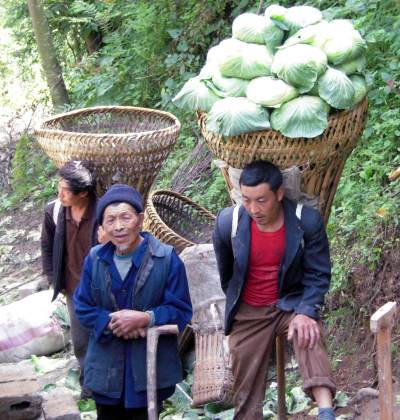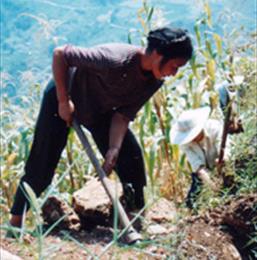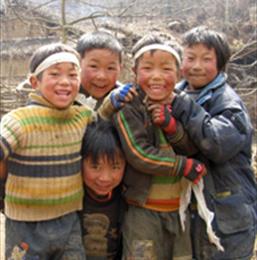Hanyuan County and Ganluo County
Sichuan Province is one of China's largest provinces. Located in the southwest of the country, it is famed for its spicy food, as the birthplace of the late Deng Xiaoping and as the natural home of the Giant Panda.
Around the provincial capital of Chengdu - a busy city with more than 12 million people living within its metropolitan area - the land is a flat, fertile plain. Irrigated by water from the Min River, in a project dating back to the 3rd century BC, this vast plain is a sea of rich green rice paddies during the summer months.
To the west of the plains the terrain rises up to mountain ranges, cut through by Asia's largest rivers, before leveling out into the Tibetan Plateau.
Hanyuan County lies some 250 km southwest of Chengdu. The county town Fulin is about 1000m above sea level, lying on Luobo Hillock at the confluence of the Dadu and Liusha rivers. The town is ringed by mountains that rise steeply up from the valley bottom to average heights of more than 2,000m. Ganluo County lies across the Dadu River in Liangshan Yi Autonomour Prefecture.
The climate is very dry throughout the year, making it a difficult environment for growing crops. The summer months are very hot, rising to about 38 degrees. This is also the wettest time of the year, with rain often falling in the evenings during wild electrical storms. In winter the peaks are covered with snow, temperatures in the valley bottoms remaining just above freezing.
Hanyuan county has a population of about 320,000 with a labour population of 170,000. The rural population accounts for 290,000 of these, mostly people living as self-sufficient farmers,in 2012 the average yearly income for farmers is about 709 pounds/person. 13% of the population are ethic groups. The labour force is 170,000. Due to the lack of local opportunities, every year between 50,000 and 60,000 people leave the county seeking work, mostly as male unskilled labourers and female childminders and waitresses. Sichuan is renowned as being the home of a large part of China's huge population of migrant labourers.
Since 2000 DORS has also been implementing community development programmes in villages in neighbouring Ganluo County. Ganluo has a population of about 210,000, and 75%of the population are Yi Minority. Ganluo County lies in Liangshan Prefecture, an Yi Minority Autonomous Region, which lies east of E’bian county and south of Meigu county and Yuexi county, and the Lesser Liangshan Mountain area, which covers the Jinsha River valley and the south bank of the Dadu River. Most Yis are scattered in mountain areas, some in frigid mountain areas at high altitudes. The altitude of the county ranges from 570 to 4288 metres above sea level. In high mountains it is very cold in winter, and in these areas, villagers just can grow some limited crops such as potatoes. The cropland is on the steep slopes of the mountains, whilst the mountain uplands are used for grazing cows and goats, and collecting fodder and firewood. .
The main industries of Hanyuan County and Ganluo County are agriculture, extractive industries, and food processing (mainly fruit). The agricultural land is fertile but dry. In the flood plains of the river valleys paddy land is used for growing rice in the summer and wheat or garlic in the winter. These crops (especially rice) require irrigation to grow in such dry conditions, so fields are linked together in a myriad of water channels that allow the fields to be flooded during the planting season.
However, most of the land is on the steep slopes of the mountains. Here the villagers grow maize and sweet potatoes on inclines that sometimes exceed 45 degrees. After the harvest in August, maize cobs are stored hanging from the roofs of the farmers' homes.
All arable land is farmed intensively, whilst the mountain uplands are used for grazing cows and goats, and collecting fodder and firewood.
Farming tasks are all done by hand, all produce was carried around in large wicker baskets strapped onto the back while now some three wheelers are adopted for transportation.

Right. A man carrying home cabbages after harvest in Wanjia Village. The man is wearing his distinctive Sichuan back basket.
Fruit trees are also grown as a cash crop on the paddy boundaries in the valley, particularly pears and apples; walnut, chestnut and cherries are grown in upland areas. In the local market as each fruit comes in to season it is announced by scores of traders who squat beside their fruit-laden back baskets shouting out to customers, "Buy cherries." In recent years trade rs also come to Hanyuan in their 12-metre trucks, transporting the fruits into all directions.
Prior to the agricultural reforms of the late 1970s the land was farmed communally. In Hanyuan the communes were disbanded in 1981 and the agricultural land was divided up and contacted out by household, including the mountain land.
The people of the countyies are mostly Han Chinese although there are other nationalities, so-called 'national minorities', with the Yi or Nuosu people being the most populous. As a border area between the Han and Yi, Hanyuan was visited frequently by missionaries and researchers earlier this century.
In 2012 the population living under the poverty line (yearly income less than £249/year/person) in Hanyuan is 40,900 , and Ganluo is designated as a national level poor county for years.. Within this framework, certain villages and households are also classified as being at various levels of poverty.
DORS selects locations for projects from amongst the poorest townships and villages. The Township (xiang or zhen) is the level below that of the district and county and functions as the lowest level of administrative government in rural China. Each is made up of several villages (cun), and each village (cun) consists of several groups (zu) which roughly correspond to hamlets or the natural villages in pre collective times. Village and group levels both have local leaders.
Since January 1997 when DORS Hanyuan office was set up, we have facilitated a number of poverty alleviation projects in 'particularly poor' villages. Their progress can be followed in our monthly newsletters.


